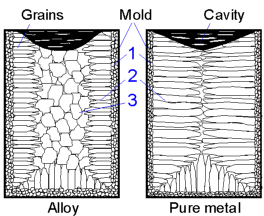 The typical structure of a cast alloy consists of three zones:
The typical structure of a cast alloy consists of three zones:
1. Chill zone - a few layers of fine equiaxed grains near the mold walls.
2. Columnar zone - oriented grains grown in the direction opposite of the heat transfer through the mold.
3. Equiaxed zone - equiaxed grains of large size at the center of the casting.
Depending on the processing conditions and material the proportion of the columnar and equiaxed zones can be altered. Slow cooling, adding the nucleating agents and agitating the melt contribute to the growth of equiaxed zone. The enlarged columnar zone is peculiar for pure metals.
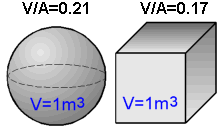 The greater the volume to surface area ratio, the slower a solid body cools and solidifies.
The greater the volume to surface area ratio, the slower a solid body cools and solidifies.
Solidification time can be estimated by Chvorinov's rule:
TS = B(V/A)2,
where V is the volume; A is the surface area; B is an empirical constant.
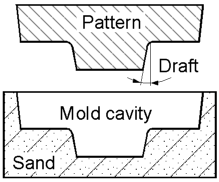 Patterns very often have a temper on the vertical surfaces parallel to the direction of withdrawal. This allows for an easy removal of the pattern from the mold without any distortion or breaking of the mold cavity. The angle of draft is normally 0.5-2o. The angle depends mainly on the materials and processing conditions.
Patterns very often have a temper on the vertical surfaces parallel to the direction of withdrawal. This allows for an easy removal of the pattern from the mold without any distortion or breaking of the mold cavity. The angle of draft is normally 0.5-2o. The angle depends mainly on the materials and processing conditions.
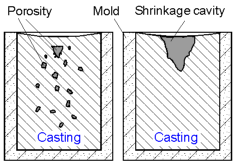 Materials with a short temperature range of crystallization (eg. pure metals or eutectic alloys) tend to form a large concentrated shrinkage cavity (right). The castings of alloys with a large freezing range have porosity dispersed in the bulk of the material (left).
Materials with a short temperature range of crystallization (eg. pure metals or eutectic alloys) tend to form a large concentrated shrinkage cavity (right). The castings of alloys with a large freezing range have porosity dispersed in the bulk of the material (left).
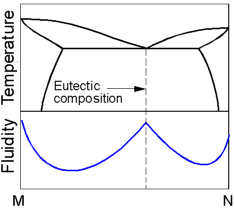 The fluidity is the capability of material to flow into mold cavities prior to solidification. The fluidity of pure metals and eutectic alloys is higher than that of hypoeutectoid or hypereutectoid alloys.
The fluidity is the capability of material to flow into mold cavities prior to solidification. The fluidity of pure metals and eutectic alloys is higher than that of hypoeutectoid or hypereutectoid alloys.
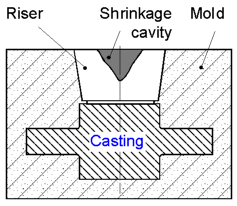 Risers are used to compensate for the shrinkage of molten metal during solidification and to avoid the formation of a shrinkage cavity within the casting. The shrinkage cavity forms into the riser because it is the last part solidified in the mold. The risers are usually located over the center of the heaviest sections of castings.
Risers are used to compensate for the shrinkage of molten metal during solidification and to avoid the formation of a shrinkage cavity within the casting. The shrinkage cavity forms into the riser because it is the last part solidified in the mold. The risers are usually located over the center of the heaviest sections of castings.
The riser must be large enough to feed the shrinkage in the casting.
Solidification shrinkage varies for different metals and influences the size of the risers.

Permanent mold casting vs Sand casting:
Increased dimensional accuracy and smoother surfaces;
A new mold to produce every part is avoided;
Increased mechanical properties due to a fine grain structure;
Less time to cast a part;
Shape and size of castings are limited;
Not suitable for metals with a low fluidity.
 2015-08-13
2015-08-13 443
443








